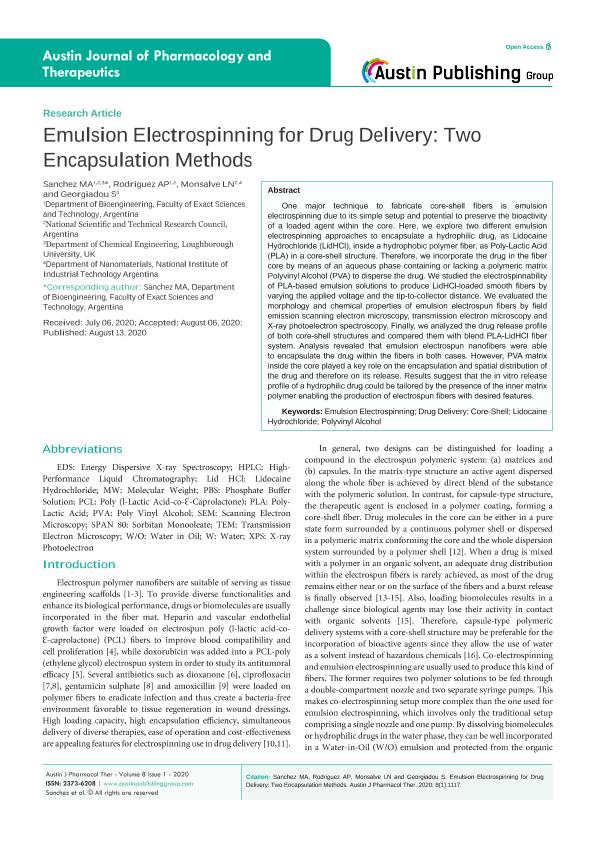Artículo
Emulsion Electrospinning for Drug Delivery: Two Encapsulation Methods
Fecha de publicación:
08/2020
Editorial:
Austin Publishing Group
Revista:
Austin Journal of Pharmacology and Therapeutics
ISSN:
2373-6208
Idioma:
Inglés
Tipo de recurso:
Artículo publicado
Clasificación temática:
Resumen
One major technique to fabricate core-shell fibers is emulsion electrospinning due to its simple setup and potential to preserve the bioactivity of a loaded agent within the core. Here, we explore two different emulsion electrospinning approaches to encapsulate a hydrophilic drug, as Lidocaine Hydrochloride (LidHCl), inside a hydrophobic polymer fiber, as Poly-Lactic Acid (PLA) in a core-shell structure. Therefore, we incorporate the drug in the fiber core by means of an aqueous phase containing or lacking a polymeric matrix Polyvinyl Alcohol (PVA) to disperse the drug. We studied the electrospinnability of PLA-based emulsion solutions to produce LidHCl-loaded smooth fibers by varying the applied voltage and the tip-to-collector distance. We evaluated the morphology and chemical properties of emulsion electrospun fibers by field emission scanning electron microscopy, transmission electron microscopy and X-ray photoelectron spectroscopy. Finally, we analyzed the drug release profile of both core-shell structures and compared them with blend PLA-LidHCl fiber system. Analysis revealed that emulsion electrospun nanofibers were able to encapsulate the drug within the fibers in both cases. However, PVA matrix inside the core played a key role on the encapsulation and spatial distribution of the drug and therefore on its release. Results suggest that the in vitro release profile of a hydrophilic drug could be tailored by the presence of the inner matrix polymer enabling the production of electrospun fibers with desired features.
Palabras clave:
Emulsion Electrospinning
,
Drug Delivery
,
Core-Shell
,
Lidocaine Hydrochloride
Archivos asociados
Licencia
Identificadores
Colecciones
Articulos(INSIBIO)
Articulos de INST.SUP.DE INVEST.BIOLOGICAS
Articulos de INST.SUP.DE INVEST.BIOLOGICAS
Articulos(SEDE CENTRAL)
Articulos de SEDE CENTRAL
Articulos de SEDE CENTRAL
Citación
Sanchez, Maria Alejandra; Rodriguez, Andrea Paola; Monsalve, Leandro Nicolas; Georgiadou S; Emulsion Electrospinning for Drug Delivery: Two Encapsulation Methods; Austin Publishing Group; Austin Journal of Pharmacology and Therapeutics; 8; 1; 8-2020; 1-8
Compartir




